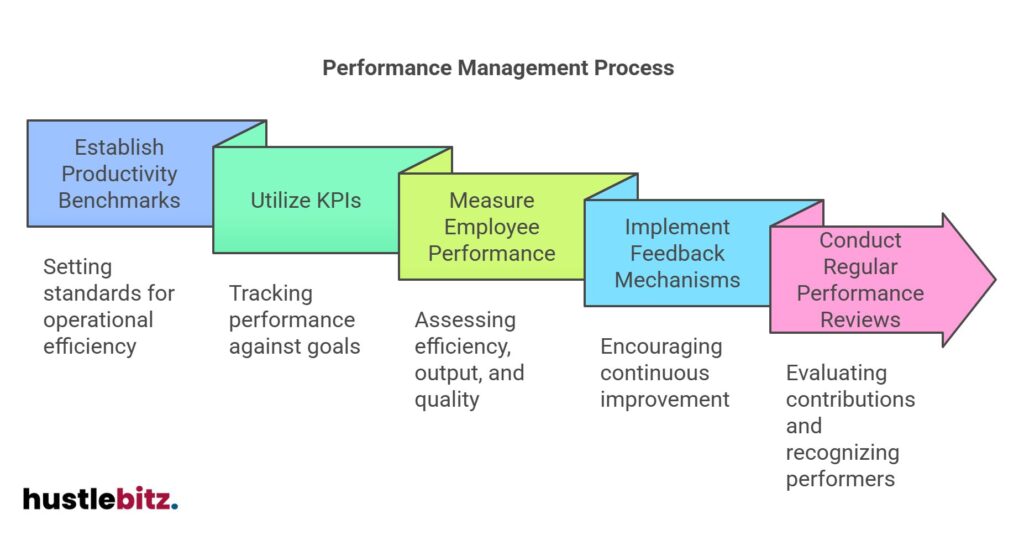Productivity metrics are vital for businesses aiming for success. They provide benchmarks for assessing operational efficiency and measuring individual contributions towards organizational goals. Key Performance Indicators (KPIs) facilitate tracking performance, while employee efficiency rates reveal insights into motivation and engagement. Additionally, metrics such as output per employee and project completion rates highlight resource management effectiveness. Quality of work measures ensure high standards, and time management metrics help identify areas for improvement. By employing these strategies, organizations can foster continuous improvement and drive productivity. For deeper insights into implementing these metrics, further exploration of this topic is beneficial.
Key Takeaways
- Establish clear productivity benchmarks to assess operational efficiency and resource allocation effectively.
- Utilize Key Performance Indicators (KPIs) to track performance against organizational goals and industry standards.
- Measure employee performance through efficiency rates, output, and quality of work to identify areas for improvement.
- Implement feedback mechanisms to foster continuous improvement and enhance employee engagement.
- Conduct regular performance reviews to evaluate contributions, recognize high performers, and inform future resource allocation decisions.

Importance of Productivity Metrics
Understanding the importance of productivity metrics is crucial for businesses seeking to optimize their operations and drive sustainable growth. By establishing clear productivity benchmarks, organizations can effectively assess their workforce engagement and operational efficiency. These metrics enable businesses to analyze how resources are allocated, ensuring that investments yield the highest possible returns.
Performance assessment is an integral aspect of productivity metrics, as it allows leaders to evaluate individual and team contributions against predefined goals. This goal alignment fosters a culture of accountability, encouraging team collaboration and enhancing overall performance. The insights gained from productivity metrics also pave the way for continuous improvement, guiding teams to refine processes and eliminate inefficiencies.
Furthermore, employing innovation metrics helps organizations gauge their ability to adapt and innovate in a competitive landscape. By measuring the impact of new initiatives, businesses can identify successful strategies and replicate them across the organization. This not only boosts operational performance but also enhances employee satisfaction, as individuals feel their contributions lead to meaningful change.
Ultimately, productivity metrics serve as a comprehensive framework for businesses to track their progress and make informed decisions. By prioritizing these metrics, organizations can create an environment that values performance and encourages collaboration, ensuring they remain agile and competitive in an ever-evolving market.
Key Performance Indicators (KPIs)
Building on the foundation of productivity metrics, Key Performance Indicators (KPIs) provide specific, quantifiable measures that enable organizations to track their performance against strategic objectives.
Effectively utilizing KPIs requires careful KPI selection, ensuring that chosen metrics align with the organization’s goals. This alignment ensures that KPIs are relevant and drive meaningful insights.
To maximize the effectiveness of KPIs, organizations should focus on the following key areas:
- KPI Benchmarking: Establishing benchmarks allows organizations to compare their performance against industry standards or competitors, providing context for KPI analysis.
- KPI Visualization: Utilizing tools such as KPI dashboards enhances visibility, making it easier for stakeholders to monitor performance and identify trends at a glance.
- KPI Reporting: Consistent and clear KPI reporting fosters accountability and supports informed decision-making. Regular reviews of KPI tracking help organizations identify areas for KPI improvement.
Moreover, integrating KPIs across various departments fosters a culture of performance accountability. This integration allows teams to leverage KPI analysis to make data-driven decisions, ultimately enhancing operational efficiency and achieving strategic objectives.
Employee Efficiency Rates

Employee efficiency rates are critical metrics that assess how effectively individuals contribute to organizational goals relative to the time and resources allocated to their tasks.
These rates provide valuable insights into employee engagement, revealing how motivated individuals feel in their roles and how this affects their overall productivity. High employee efficiency often correlates with effective performance feedback systems and robust skill development programs, which equip staff with the tools necessary to excel.
Moreover, maintaining a proper workload balance is essential for optimizing employee efficiency. Overburdened employees may experience burnout, leading to decreased productivity and higher absenteeism rates. Conversely, employees who feel adequately challenged and supported are more likely to demonstrate high efficiency and job satisfaction.
Motivation factors, such as recognition and opportunities for team collaboration, also play a significant role in enhancing employee efficiency. When team members work cohesively, they can share knowledge and resources, leading to improved outcomes.
Additionally, the effectiveness of training programs directly influences efficiency; well-structured training ensures that employees are well-prepared to tackle their responsibilities.
Output Per Employee

Output per employee serves as a vital metric that quantifies the total contributions of each staff member within an organization, reflecting both individual performance and the overall efficiency of the workforce.
As businesses strive for workforce optimization, understanding output per employee can guide strategic decisions in various areas, including employee engagement and skill development.
To effectively assess output per employee, organizations should consider the following key aspects:
- Output Benchmarking: Comparing output metrics against industry standards helps identify performance gaps and highlights areas for improvement.
- Technology Impact: Utilizing productivity tools can significantly enhance output by streamlining processes and facilitating team collaboration, especially in remote work settings.
- Performance Reviews: Regular evaluations not only promote accountability but also encourage employee satisfaction by recognizing achievements and identifying development opportunities.
By focusing on these areas, businesses can foster an environment where employee engagement thrives, leading to improved productivity.
Additionally, investing in skill development initiatives equips employees with the necessary tools to excel in their roles, further enhancing output metrics. The alignment of team goals and individual contributions is essential, as it promotes a culture of collaboration and shared success.
Ultimately, a clear understanding of output per employee empowers organizations to make informed decisions that drive growth, enhance employee satisfaction, and improve overall business performance.
Time Management Metrics

Effective time management metrics are essential for businesses aiming to optimize productivity and ensure that resources are utilized efficiently. By measuring time allocation across various tasks and projects, organizations can identify areas for improvement and enhance overall performance. Utilizing task prioritization techniques enables teams to focus on high-impact activities, thus driving better results.
Time tracking is a pivotal component of effective time management, allowing businesses to monitor how time is spent and identify inefficiencies. Regular time audits can reveal patterns of productivity and highlight distractions, making it easier to implement distraction management strategies. By understanding where time is lost, organizations can develop focus strategies that foster a more concentrated work environment.
Incorporating advanced productivity tools can further streamline time management practices. These tools assist in scheduling techniques that promote a balanced workload and support work-life balance, essential for employee satisfaction and retention. Goal setting is an integral part of this process, as it provides clear objectives and benchmarks for success, guiding teams in their daily tasks.
Quality of Work Measures

Measuring the quality of work is vital for organizations seeking to enhance overall productivity and ensure that time and resources are being invested in high-standard deliverables. High work quality not only reflects the effectiveness of processes but also contributes to customer satisfaction and long-term success.
To achieve meaningful assessments, businesses should focus on several key aspects:
- Performance Standards: Establish clear benchmarks that define what high-quality work looks like. These standards should be aligned with organizational goals and customer expectations, allowing employees to understand the level of quality required.
- Feedback Mechanisms: Implement regular feedback loops that enable employees to receive constructive criticism and recognition. This encourages continuous improvement and fosters employee engagement by making individuals feel valued and motivated to enhance their skills.
- Error Rates and Innovation Metrics: Track error rates to identify areas needing improvement. Additionally, monitor innovation metrics to gauge how effectively teams collaborate and innovate. A high collaboration effectiveness often leads to better problem-solving and efficiency in delivering quality products or services.
Project Completion Rates

Project completion rates serve as a critical indicator of an organization’s ability to deliver on commitments and manage resources efficiently. By measuring the percentage of projects completed on time and within budget, businesses can assess their effectiveness in adhering to project timelines. High completion rates typically reflect strong resource allocation, where teams are equipped with the necessary tools and personnel to succeed.
Effective project management hinges on team collaboration and task prioritization. When teams work cohesively, they can streamline efforts and optimize workflows, leading to improved completion rates. Additionally, integrating agile methodologies enhances adaptability, allowing organizations to respond swiftly to changes and challenges. This flexibility is crucial for maintaining momentum and ensuring that client satisfaction remains a top priority.
Regular risk assessment is also vital in understanding potential obstacles that could hinder project completion. By identifying risks early, teams can implement strategic measures to mitigate issues before they escalate. Incorporating feedback loops within project workflows promotes continuous improvement, enabling teams to refine their processes based on real-time insights.
Performance reviews serve as a formal mechanism to evaluate project completion rates, providing valuable data for assessing individual and team contributions. By analyzing these metrics, organizations can identify patterns, recognize high performers, and address areas needing improvement.
Ultimately, focusing on project completion rates not only enhances operational efficiency but also strengthens client relationships, as timely delivery fosters trust and satisfaction.
Final Thoughts
Productivity metrics are essential tools for businesses striving to optimize efficiency and drive success. By focusing on key performance indicators, employee efficiency, output per employee, and other relevant metrics, organizations can gain valuable insights into their operations. These metrics provide a roadmap for continuous improvement, enabling businesses to make informed decisions, allocate resources effectively, and foster a culture of accountability and excellence. Regularly assessing and refining these metrics ensures that organizations remain agile and competitive in an ever-evolving marketplace. Embracing these strategies will not only enhance productivity but also contribute to long-term growth and success.




